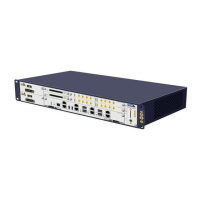ZXR10 ZSR V2 Series Router Product Description
ZTE Confidential & Proprietary 33
3.6.1 Flow Classification and Flow Tag
Based on the classification strategies such as destination MAC, source MAC, VLAN ID,
802.1P, ToS/DSCP, and IP 5-tuple (protocol type, destination IP, source IP, destination
port number, source port number), service packets are divided into multiple priorities or
categories. Ethernet packet CoS, ToS or DSCP of IP packet head, and EXP field of
MPLS can be tagged to implement scheduling based on the categories, congestion
management, and traffic shaping. QoS for different service types can be provided.
3.6.2 Traffic Monitoring
Take token bucket algorithm and restrict the traffic enters the network within a proper
range. Manage and punish the exceeding part. For example, drop the packet, color the
packet, or re-set the priority of the packet, in order to protect the network resource and
operators’ benefits. ZXR10 ZSR V2 supports srTCM (single-speed three-color) and
trTCM (dual-speed and three-color) algorithms. It also supports Color-Blind and
Color-Aware coloring mode. ZXR10 ZSR V2 supports port-based and traffic-based
coloring, which can be applied in both incoming and outgoing directions.
3.6.3 Traffic Shaping
Traffic shaping buffers and sends outgoing traffic at an even rate meet the processing
capability of the downstream equipment. ZXR ZSR V2 supports port-based and
queue-based traffic shaping.
3.6.4 Queue Scheduling
Queue scheduling solves the congestion problem at the network node by a series of
scheduling algorithms. By scheduling, the packets with high priority are first forwarded.
The packets with low priority can also fairly get corresponding scheduling opportunity.
ZXR10 ZSR V2 supports queue scheduling of PQ (Priority Queuing), Weighted Fair
Queuing(WFQ) and CBWFQ,etc..

